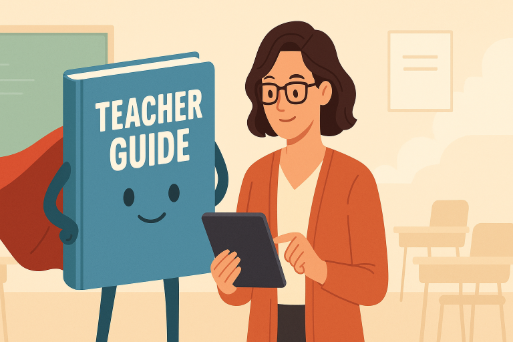The Value of Teacher Guides in K-12 Classrooms: Enhancing Learning with Brightspace


When it comes to setting up a smooth-running, engaging classroom—whether in person, online, or somewhere in between—one unsung hero deserves more credit: the teacher guide. These behind-the-scenes powerhouses help educators feel confident, prepared, and supported as they deliver meaningful learning experiences. Especially in K–12 classrooms using Brightspace, teacher guides can make all the difference between just getting through the week and truly connecting with students. Let’s take a closer look at what they are, why they matter, and how they can transform your teaching.
🧭 What Are Teacher Guides?
Think of a teacher guide as the blueprint for a course. Also known as instructional guides or course guides, they lay out the learning objectives, recommended pacing, key resources, lesson plans, suggested activities, and assessment strategies and tips—all in one place. Whether built into Brightspace or added alongside course content, a well-designed teacher guide helps educators quickly understand not just what students are learning, but how and why they’re learning it.
💡 Why They Matter in a Brightspace Classroom
Brightspace offers tons of flexibility when it comes to designing and delivering content. But that flexibility can sometimes be overwhelming—especially when you're covering multiple grades or subjects. That’s where teacher guides shine. They provide structure without being restrictive and help educators make the most of the platform’s tools, like assignments, rubrics, discussion boards, and multimedia integration.
Having a teacher guide embedded in a Brightspace course means that teachers don’t have to reinvent the wheel. Newer teachers feel more confident jumping into a course, and experienced teachers can spend less time figuring out logistics and more time focusing on students.
🛠️ What Makes a Great Teacher Guide?
A good teacher guide doesn’t just list the week’s activities. It offers context, suggestions, and flexibility. Here are a few features that really help:
- Clear learning goals: Show what students should know or be able to do by the end of a unit or lesson.
- Suggestions, not scripts: Offer ideas for delivery, but leave room for teacher choice.
- Assessment guidance: Provide options for formative and summative assessment.
- Platform-specific tips: Point out useful tools or features within Brightspace.
- Adaptation notes: Suggest how to modify lessons for different learning needs or classroom settings.
🚀 What a Teacher Guide Can Do for You
Here’s how a well-crafted teacher guide can elevate your teaching and create a more streamlined, supportive, and impactful classroom experience:
- Saves time: With ready-to-use resources and guidance, teachers can focus more on students and less on setup.
- Supports consistency: When used across multiple classrooms or schools, teacher guides help align instruction and expectations.
- Enhances collaboration: They facilitate teamwork among educators by providing a common framework for teaching.
- Fosters adaptability: With built-in suggestions, teachers can adjust lessons for diverse learners and teaching styles.
- Builds confidence: Whether you're new to Brightspace or a seasoned pro, guides provide a helpful foundation.
In conclusion, integrating teacher guides into K-12 classrooms using Brightspace is more than just a best practice—it's a game-changer for educators and students alike. They create a solid foundation for effective teaching, no matter where learning is happening. If you're not already using them, it might be time to take a second look—they’re well worth it.
Want to Learn More?
Connect with your institute's D2L Customer Success Manager or Client Sales Executive, or reach out to the D2L Sales Team for more information about how Learning Services can support you on your learning journey.
